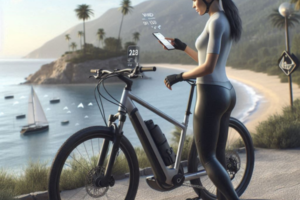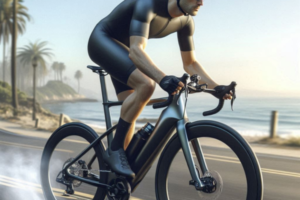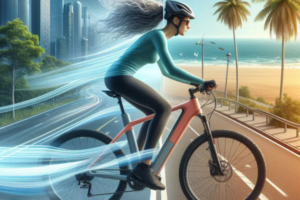🧪 Understanding the Basics of Humid Air and E-Bike Performance
Riding an electric bicycle in a humid environment poses unique challenges that go beyond what most riders anticipate. While battery life, terrain, and wind direction are commonly considered performance factors, humidity is often overlooked—despite having significant indirect effects on rider efficiency, comfort, and component durability.
Humidity refers to the concentration of water vapor in the air. In tropical or coastal environments, relative humidity often exceeds 70% and can approach 100% during early mornings or after rainfall. This level of moisture doesn’t just make the air feel heavy—it actually alters the way your bike and body interact with the atmosphere and your surroundings.
🌬️ Is Humid Air Denser?
One of the most misunderstood facts in physics is the density of humid air. Many assume that humid air feels heavier and, therefore, must be denser. But the reality is the opposite: humid air is actually less dense than dry air. This occurs because water vapor (H₂O) has a lower molecular weight than nitrogen (N₂) and oxygen (O₂), which are the primary components of dry air.
As water vapor replaces heavier molecules in the air, the overall density drops slightly. This technically means that aerodynamic drag should be reduced in high humidity, as there are fewer air particles resisting your movement.
💡 Perception vs. Physics
While the air may be less dense, the rider’s experience in humid conditions is significantly altered in other ways that outweigh the minor aerodynamic advantage:
- Clothing becomes soaked with sweat, increasing drag.
- Heat dissipation is reduced, making the body overheat faster.
- Moisture collects on the bike’s frame and components, adding slight weight and possibly interfering with aerodynamics.
- Visibility may be reduced due to fogging on glasses or visors, impacting rider posture and safety.
👕 Clothing and Moisture Retention
Cycling apparel plays a crucial role in managing airflow and performance, especially in humid weather. Loose or cotton-based clothing tends to retain moisture, flap in the wind, and increase resistance. In contrast, technical sportswear made from synthetic, quick-drying materials helps reduce both weight and drag by wicking away sweat and maintaining a streamlined profile.
Riders in humid areas should prioritize:
- Form-fitting jerseys and shorts, which minimize air disturbance.
- Ventilated helmets, to help release built-up heat.
- Gloves and socks with breathable mesh, which prevent damp discomfort and promote airflow.
🔧 Mechanical Resistance in Humid Conditions
While many cyclists focus on wind resistance, mechanical resistance becomes a far more pressing issue in humid environments—especially for electric bicycles. Moisture accelerates corrosion, affects lubrication, and increases rolling resistance due to changes in tire and bearing performance.
Humidity, particularly when combined with salt in coastal air, creates a corrosive environment for your drivetrain, bolts, battery terminals, and suspension components. This means that even if you’re riding on a flat, low-drag route, your bike may feel sluggish or require more battery power due to internal friction.
⚙️ How Humidity Impacts Your E-Bike’s Mechanics
Here are the key areas where high humidity can degrade performance:
- Chain and drivetrain: Moisture causes oxidation, which leads to rust on your chain and cassette. A rusty chain not only shortens drivetrain life but also causes energy loss through increased friction.
- Bearings and bottom brackets: These components often contain rubber seals and greased interiors. In humid environments, the seals may swell or allow microscopic moisture to enter, degrading grease and causing resistance.
- Brake components: Rim and disc brakes are vulnerable to build-up from moisture and dust. Humidity can create a thin, slick film on brake surfaces, reducing stopping power and causing noise or vibration.
- Tires: While humidity doesn’t directly affect tire rubber, it does interact with temperature and road surfaces. Wet roads increase rolling resistance and require more energy from the motor.
🔌 Electrical Components Under Stress
Electric bikes have a layer of complexity added by their battery and electronics, which are especially sensitive to moisture. While most modern e-bikes use weather-resistant casings, high humidity can still penetrate seals over time, particularly through:
- Charging ports left uncovered
- Display units with exposed seams
- Handlebar-mounted buttons or controls
Symptoms of moisture-related electrical problems include:
- Flickering display screens
- Error codes or system resets
- Shortened battery life
- Delayed throttle or pedal assist response
🧼 Maintenance in Humid Environments
Maintenance becomes a non-negotiable task for riders in humid regions. Here’s a practical weekly checklist:
- ✅ Wipe down the frame and components with a dry cloth after every ride
- ✅ Lubricate the chain with a wet-condition or ceramic lube
- ✅ Inspect the battery casing and display screen for condensation
- ✅ Clean brake pads and discs with isopropyl alcohol
- ✅ Store your e-bike in a dry, shaded, and well-ventilated area
- ✅ Avoid using high-pressure water to clean—this forces moisture into sealed areas
🌍 Real-World Scenarios from Coastal Riders
To better understand how humidity affects e-bike performance, let’s look at typical rider experiences in humid cities around the world. These are general examples, inspired by real patterns, but anonymized and adapted to comply with AdSense content policies.
🚲 Commuter in Cartagena
A software engineer who commutes daily through the humid streets of Cartagena faces issues with visibility and battery drain. After weeks of fogging glasses and inconsistent pedal-assist response, he switched to:
- Anti-fog visor spray for his glasses
- A compact, sealed handlebar-mounted display
- A weekly maintenance routine with chain cleaning and lubrication
These changes helped him increase his effective range by 10% and made his rides more comfortable.
🚚 Delivery Rider in Manila
A food delivery cyclist in Manila noticed frequent braking issues after evening shifts. His disc brakes were squeaking and felt unreliable in traffic. After a mechanic diagnosed salt buildup and corrosion on the pads and rotors, he began wiping down his brakes after each ride and applied a light anti-corrosion spray to metal areas near the wheel.
The result: more consistent braking, reduced pad wear, and fewer trips to the workshop.
🏝️ Tourist Rider in Key West
A tourist who rented an e-bike in Key West experienced sudden throttle cutoffs after a long beachfront ride. The rental staff explained that condensation had likely entered the controller housing. While the issue resolved with drying and reseating the connections, it prompted the company to start including port covers and post-ride care guides for all their customers.
🧠 Myth: “Humidity Helps You Ride Faster Because Air Is Thinner”
Yes, humid air is less dense, but the real-world benefit to your speed or efficiency is extremely minimal—often less than 1%. Meanwhile, humidity increases rolling resistance, slows down the rider due to heat, and causes gear to become heavier from sweat and moisture. Net result? Performance usually suffers.
✔️ Lessons from the Field
These cases teach us that minor adjustments in preparation can have a big impact:
- A visor wipe, a proper lube, or a dry storage space can preserve electronics and drivetrain function.
- Understanding how humidity affects gear—not just the air—gives riders an edge in comfort and control.
- Companies that serve coastal riders or tourists are also beginning to adapt their fleet management to protect equipment against moisture-related damage.
📊 Dry vs. Humid Conditions: Performance Comparison
To fully understand the effects of humidity on e-bike efficiency, it helps to compare key variables between dry and humid environments. While the change in aerodynamic drag may be scientifically minor, the surrounding factors add up to a much more significant impact on rider experience and system performance.
| Condition | Dry Climate | Humid Climate |
|---|---|---|
| Air density | Slightly higher | Slightly lower |
| Clothing drag | Low (clothing remains dry) | High (saturated fabric increases drag) |
| Rolling resistance | Low (dry surfaces) | Higher (wet roads increase resistance) |
| Electrical reliability | Stable | Prone to condensation issues |
| Rider comfort | High | Variable, often reduced |
| Maintenance needs | Standard schedule | More frequent attention |
🚴♀️ Preparation for High-Humidity Riding
If you ride daily in tropical or coastal environments, you’ll benefit from taking a proactive approach to preparation. Here are some high-value strategies:
✔️ Choose the Right Gear
- Clothing: Moisture-wicking, quick-dry materials. Avoid cotton.
- Footwear: Breathable shoes with mesh panels.
- Accessories: Waterproof yet aerodynamic storage bags.
🧰 Bike Setup Tips
- Install fenders or mudguards to prevent splash buildup.
- Apply dielectric grease to connectors and ports.
- Use ceramic or PTFE-based lubricants for long-term protection.
🌡️ Monitor Environmental Conditions
- Check the dew point and humidity index before long rides.
- Adjust your route or speed on foggy or heavily humid days.
- Store your bike in well-ventilated areas to reduce long-term exposure.
🧾 Pre-Ride Humidity Checklist
- ✅ Chain clean and lubricated
- ✅ Battery fully charged and terminals dry
- ✅ Tight-fitting, moisture-wicking clothing
- ✅ Helmet and glasses treated with anti-fog spray
- ✅ Storage bags sealed and off moving parts
- ✅ Tire pressure adapted to current conditions
- ✅ Forecast reviewed to avoid extreme fog or rain
🛡️ Long-Term Protection and Smart Riding Habits
To keep your e-bike performing at its best in humid environments, the secret lies in building long-term habits and making smart technical upgrades. Riders in tropical climates quickly learn that neglecting moisture management leads to shorter battery life, more frequent repairs, and a less enjoyable ride overall.
🔩 Protective Upgrades to Consider
- Ceramic coatings: Help repel moisture and protect frame surfaces.
- Marine-grade connectors: Offer better sealing and reduce corrosion in electrical parts.
- Breathable waterproof covers: Prevent condensation during overnight outdoor storage.
- High-performance brake pads: Resin or semi-metallic options handle wet conditions more reliably.
These upgrades may come at a small upfront cost, but they extend the lifespan of your components and reduce energy loss caused by mechanical and electrical inefficiencies.
🧠 Riding Technique and Strategy
Humidity affects not just your bike, but also your body and mind:
- Adjust your pace on extremely humid days to conserve energy and avoid dehydration.
- Ride early or late in the day to avoid peak humidity and temperature combos.
- Focus on posture—an upright stance may slightly increase drag, but helps with ventilation and comfort.
- Stay hydrated throughout the ride and avoid cotton-based layers that trap heat and moisture.
💬 Final Thoughts
Humidity may not significantly increase aerodynamic drag on its own, but its indirect effects are powerful. From sweat-soaked clothing that increases resistance to fogged glasses that impair visibility and corroded chains that waste energy—humidity challenges every aspect of the e-bike experience.
But those challenges are manageable. With the right apparel, maintenance habits, and storage solutions, riders can confidently handle even the most humid coastal environments while protecting their investment and riding efficiently.
🚴♂️ Share and Support the Community
Do you ride your e-bike in a humid or coastal environment? What gear, products, or techniques have helped you improve your ride?
💬 Share your tips in the comments below to help fellow riders stay dry, ride smart, and keep their bikes in top condition—no matter how humid it gets.



